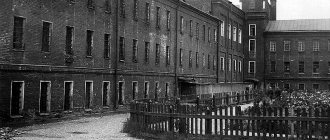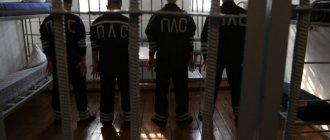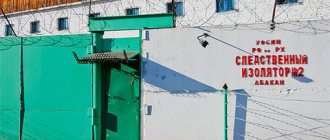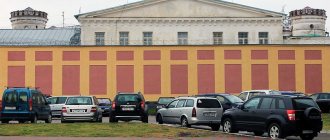The Lefortovo pre-trial detention center dates back to 1881. The prison was built under Alexander II and was originally intended for short-term detention of lower military ranks. The correctional facility was built according to the design of the architect P. N. Kozlov. However, subsequently the Lefortovo prison was completed and rebuilt many times. After the events of October 1917, the correctional institution came under the jurisdiction of the Cheka. Later, the prison was administered by organizations such as the NKVD, KGB and FSB.
It is almost impossible to find information about the pre-trial detention center in Lefortovo in public historical sources. Even local historians who specialize in studying this area of Moscow cannot tell anything about this prison. Today the correctional institution is operational; since 2005 it has been under the department of the Ministry of Justice. There are rumors that among the staff and representatives of the administration of the pre-trial detention center there are still many FSB officers. It is still almost impossible for outsiders to get into this prison. Journalists are not allowed here, press conferences are not held here.
general information
- Official website: none.
- Number of prisoners: 200 convicts.
- Official name: FBU IZ-1/1 Federal Penitentiary Service for Moscow.
- Management: Head of the pre-trial detention center - Vladimir Repkin.
- Phones:.
- How it works: Monday to Thursday from 09:00 to 16:00, from 13:00 to 14:00 – lunch break.
- Address: st. Lefortovo Val, 5 (Energeticheskaya St., 3a).
Prison on the map:
Famous facts about Lefortovo
The correctional facility also has several escapes on its record. For example, in 1920, convicts Grigory Kletkin and Sergei Drozhennikov escaped from here. While repairing the heating system, they made a hole right in the floor. There were also prisoners who managed to bribe the guards.
Among the famous prisoners, Alexander Mikhailovich Krasnoshchekov can be noted. In 1922, he had an affair with Lilya Brik. This connection almost led to the girl’s separation from Mayakovsky. They said that Krasnoshchekov used public funds for his own purposes, often ugly. As punishment for abuse of power, he was sentenced to six years in solitary confinement.
In 1922, the prison became a haven for many street children, as well as poor families with children. In 1923, bathhouses were built in the colony, and later a pharmacy was equipped. Within a year, the prison begins to play the role of a pre-trial detention center.
History of the prison
Initially, only war criminals who were given short sentences were kept here. During this time, the establishment was regularly reconstructed.
In the twenties of the 20th century, the building was called the Moscow Lefortovo prison - distribution center. Afterwards it became a special isolation ward.
Those who were given ten years of complete isolation instead of execution were brought here. In the thirties, retraining occurred again, and the detention center turned into a forced labor colony. However, five years later, the NKVD took possession of it and equipped it as a prison in which people under investigation were kept.
Since the fifties, the prison became the property of the KGB and became a pre-trial detention center. Soviet dissidents were brought here - informalists, bright artists and many others.
From the early nineties of the 20th century until the mid-2000s of the 21st century, the insulator was used by the Russian FSB. At the moment this is the Lefortovo pre-trial detention center.
Horrors of Lefortovo dungeons
Too little is known about Lefortovo’s past. The most objective are considered to be the meager memories of people who were there as prisoners. The stories about the “mental violence” chambers seem to be the most terrifying. These are special rooms for “offenders” with walls painted black. They say that the bright electric light in the gloomy punishment cells did not go out around the clock.
In the 20s of the last century, the building of the Central Aerodynamic Institute was located next to the famous prison. A wind tunnel was built at the scientific institution. When it worked, the prisoners “enjoyed” the noise and very strong vibrations. They say that sometimes they even caused dishes to move across the surface of tables.
Many scary stories are told about the underground tiers of the prison. According to some versions, prisoners in them were subjected to severe torture, and sometimes it came to execution. Whether this is true or false, we can only guess.
What is modern Lefortovo - a pre-trial detention center or a torture chamber? Despite the level of secrecy, the prison is regularly inspected by the Prosecutor General's Office of the Russian Federation, and once representatives of the Red Cross even visited it. No violations were identified, the conditions of detention of prisoners were considered good. Today Lefortovo is sometimes jokingly called a “cell detention center” due to the small number of prisoners and the calm local atmosphere.
Photo
See below for photos of the Lefortovo prison in Lefortovo:
Prisoners - who are they?
The full correct name of the Lefortovo remand prison is FKU Pre-trial Detention Center No. 2 of the Federal Penitentiary Service of Russia. Today, people under investigation are being held here awaiting trial. Most local prisoners are involved in cases investigated by the FSB. There are also very famous and influential people among them. Among modern prisoners, the most famous is Deputy Minister of Finance Sergei Storchak. The prison also has its own caste of “poor” - illegal immigrants, whose affairs are also dealt with by the FSB. And yet the vast majority of local prisoners are wealthy and quite interesting people. What is noteworthy is that in the modern history of the detention center, almost no one complains about the conditions of detention.
Features of the establishment
In Lefortovo, the prison looks like a building with four floors. Each of them has 50 cameras. It is curious that in this institution there are completely no commodity-money relations and the so-called “rope telegraph” between the convicts.
In addition, journalists are allowed here only on special occasions and invitations. Free access is possible only for lawyers, and not for everyone.
IMPORTANT! The only reliable information available is the plan of the prison. However, many people consider it incomplete because it does not show many objects. This is also due to the fact that the KGB and FSB categorically forbade anyone to write anything about the prison. All possible information was confiscated, and its authors were sent to prison.
Conditions of detention
The pre-trial detention center is designed to hold 300 prisoners . This place is quite mild, at present, in terms of keeping convicts (compared to the same Matrosskaya Tishina).
The chamber has an area of 8 sq.m. There are 2-3 people in it. The beds are arranged in tiers, the room has a refrigerator (yes, yes!), a TV (imagine that!), a table and benches, a shelf and a window with bars. Not a single pre-trial detention center has ever heard of such “cute” content. In Matrosskaya Silence the administration would have laughed, and the prisoners would have been despondent upon learning about their detention in Lefortovo.
Since 2022, hot water (hot water!) has been supplied to prisoners’ cells; until now there was only cold water. Hot water is turned on in the cells only for three hours. The bathroom is not separated from the cell.
Prisoners go to the toilet in a duck. Once a week prisoners are allowed to go to the bathhouse . Unlike other places of detention in Lefortovo, prisoners suffer less from contagious skin diseases due to the fact that they can wash themselves more often.
Convicts in Lefortovo can wear their own clothes. The building of this MLS is constantly undergoing renovation work, the cells are always clean, and prisoners do not complain about the conditions. Every day a person on duty is assigned to the cell, who is responsible for maintaining cleanliness and order. If something happens, the demand will come from him.
The pre-trial detention center does not have a “rope telegraph” system, with the help of which prisoners can transfer various objects to each other. Drugs and mobile phones do not come here .
Schedule
An approximate daily schedule is presented in the table:
| Climb | 6:00 |
| Morning toilet and cleaning of beds | 6:00-6:30 |
| Cleaning the cells | 6:30-7:00 |
| Breakfast | 7:00-8:00 |
| Morning check | 8:00-9:30 |
| Walking, sanitizing rooms | 9:30-12:00 |
| Personal time | 12:00-13:00 |
| Lunch | 13:00-14:00 |
| Walk, personal time | 14:00-17:00 |
| Dinner | 17:00-18:00 |
| Cleaning the cells | 18:00-19:00 |
| Personal time | 19:00-20:00 |
| Evening check | 20:00-21:30 |
| Preparation for sleep | 21:30-22:00 |
| Dream | 22:00 |
Nutrition
Meals in the pre-trial detention center are provided three times a day . Every day 72 rubles are spent per prisoner. The daily ration of one prisoner is 2600-3000 kcal. They eat in their own cells, food is passed through windows in the doors.
Sample menu in a pre-trial detention center
- Breakfast:
- pearl barley, oatmeal or millet porridge cooked in water;
- a piece of butter;
- bread;
- cocoa.
- Dinner:
- for the first course - cabbage soup, rassolnik, solyanka, borscht or pea soup;
- for the second - mashed potatoes, buckwheat or rice with a cutlet or meat, a glass of compote and a slice of bread.
- Dinner:
- buckwheat;
- mashed potatoes;
- rice porridge with fish or meat;
- cottage cheese or yogurt;
- a glass of juice;
- bread.
In the pre-trial detention center, food salt is not placed on the table for prisoners. They eat dishes as salty as they come, regardless of preference. This is explained by the fact that many convicts often rubbed their armpits with salt, after which they developed a high temperature. In this way they tried to avoid trial.
Work and study
In Lefortovo, prisoners do not work or earn money , and also cannot receive education or study. They are only allowed to study on their own, read books and lectures, and study something on their own.
Religious issues
Previously, there was a church on the territory of the detention center, but it is currently closed.
Nevertheless, on major holidays, the priest comes to the pre-trial detention center to talk with prisoners . Convicts are not prohibited from carrying religious items:
- cross;
- icons;
- books and more.
Entertainment and relaxation
Every day, prisoners are taken for a walk to a special room located on the roof of the building. You can get there by taking a special service elevator. Such rooms are 12 meters long; instead of a roof over their heads, prisoners have bars through which they can see the sky. Walks are taken several times a day.
Prisoners are allowed to watch TV in their cells (the program is created by the management of the pre-trial detention center itself) and use their own leisure facilities: books, games.
On holidays, the pre-trial detention center club organizes various events for them, in which they can also take part. They are allowed to visit the library and borrow books to read.
There is a medical center on the territory of the pre-trial detention center, where prisoners are often examined for serious diseases. Lefortovo monitors the health of its prisoners very carefully.
Dates and visits
In the pre-trial detention center, visits with relatives and a lawyer are allowed . Suspects and accused of a criminal offense may have 2 visits lasting no more than three hours.
Before obtaining permission to visit, you must write a corresponding petition. After its consideration and permission, a stamp is placed on the letter, and it is also indicated with whom and when the prisoner is allowed to visit. No more than 2 people are allowed on a date.
Transfer of products and things
Suspects and accused of a crime have the right to receive parcels without limiting their number monthly. The weight of all parcels per month should not exceed 30 kg. Exceptions to the weight limit for parcels include disabled people, the sick and those suffering from serious illnesses (subject to a medical certificate). Each package received is checked for prohibited items.
Among them:
- drugs;
- alcohol;
- products that pose a danger to life;
- weapons of crime;
- sharp and cutting objects.
If prohibited items hidden in a certain way during inspection are found in the parcel, the person who transferred the parcel will be brought to administrative or criminal liability (depending on the content of the parcel).
Suspects can be transferred money , with which they have the right to purchase food and basic necessities at a local stall. The money is credited to their personal accounts. With the permission of the management of the pre-trial detention center, defendants can also transfer money to their relatives and loved ones.
In accordance with the order of the Ministry of Health and Social Development of the Russian Federation No. 640, the Ministry of Justice of the Russian Federation No. 190 of October 17, 2005 “On the procedure for organizing medical care for persons serving sentences in places of deprivation of liberty and those in custody,” the administration is obliged to accept and transmit medical transfers to prisoners, but only with the permission of a doctor Pre-trial detention center.
Punishment cell
For bad behavior and non-compliance with the regime of the pre-trial detention center, convicts can end up in a punishment cell (punishment cell). You can spend up to 14 days in it. There is no TV or refrigerator in the punishment cell; you are not allowed to go for a walk or do personal business. Not to say that the punishment cell in Lefortovo is the horror of horrors.
If you carefully read the paragraph about the contents, you already know that in ordinary cells here, well, let’s say, like in a colony settlement - a TV, a refrigerator, everything. But the punishment cell here resembles the usual (!) regime of detention in other pre-trial detention centers or in a general regime penal colony. That is, everything is a level more comfortable. So it’s difficult to consider the punishment cell in Lefortovo a punishment cell, but, of course, it’s not for us to judge.
Want to know about the most terrible Russian prisons? We offer information about the Black Golden Eagle, Vologda Pyatak, Butyrka, Polar Owl, White Swan, Black Dolphin, Sailor's Silence, Snezhinka and Vladimir Central.
Prison Breaks
Officially, only a few people fled from Lefortovo:
- 1994 Two prisoners under investigation were painting a fence. The guards did not watch them carefully. The convicts took advantage of the situation and escaped. However, the escape did not last long, and by evening they were returned. Security has been beefed up.
- 2005 year. A resident of Uzbekistan, accused of rape, was transported in a paddy wagon. He managed to open it unnoticed by the guards and escape. It took a week to find him and send him back to prison.
- 2005, March. The robber from Kyrgyzstan improved the situation and ran away from Lefortovo. Was found a few days later. The security was seriously punished.
It is unknown how many unofficial escapes there were. The management of Lefortovo prison insists only on the three that were given above. Other escapes have been claimed by different individuals, but each remains unconfirmed.
Silence and secrets of architecture
Inside, the Lefortovo detention center is qualitatively different from all other prisons of the same age. The main residential complex is built in the shape of the letter "K". At the point where all three corridors connect is the main observation point of the floor. Gendarmes once sat at an ancient massive wooden table. Today there are computers here that broadcast video from surveillance cameras.
Behind the shift manager you can see statues of Atlanteans, while the table itself rests on massive lion paws. The residential building has four floors, with no concrete floors between them. Being at the junction of the rays of the letter “K”, you can admire the entire interior of the building from bottom to top. Along the perimeter of the walls there are iron mesh terraces. Personnel move along them, whose duties include looking through the peephole of each camera every minute. Typically, one controller monitors 12 cameras at once.
Inside, the Lefortovo prison does not look much like a pre-trial detention center. The corridors are lined with carpets, but this is a purely practical decision that has nothing to do with creating coziness. The soft floor covering dampens the sound of footsteps. This means that prisoners do not hear the guards approaching the cell doors. Lefortovo prison boasts phenomenal silence. All sounds here seem to be drowned in cotton wool. It is quite possible that this is a feature of the layout of the pre-trial detention center buildings.
The pre-trial detention center is designed to hold 300 people at a time. According to the initial design, the prison is equipped with about 205 cells. Today, most of them are intended to hold 2-3 prisoners. These days, the legendary prison rarely houses more than 200 prisoners at a time. However, the administration of the pre-trial detention center does not name the exact number of prisoners. Also, correctional facility staff are prohibited from communicating with outsiders on this topic.
How to get there?
As mentioned above, getting into pre-trial detention center No. 2 is very difficult. Naturally, only employees of the detention center itself, as well as persons who have committed serious crimes (prisoners), can easily enter the detention center. For everyone else, including lawyers, entering Lefortovo is very problematic and long.
The fact is that, despite the large number of prisoners held in the isolation ward, there are only 6 cells in which they can communicate with their lawyers. Therefore, many defense lawyers cannot get so-called visits with their clients for weeks.
Surprisingly, lawyers have to draw lots: there is a person on duty near the detention center building around the clock who keeps a list of the list of lawyers. The defenders enter their data into the list, after which they draw lots: whoever gets the “lucky ticket” gets through.
It has always been difficult to get into the detention center, since it houses citizens accused of committing the most high-profile crimes. Therefore, many lawyers have to wait in line at night and stand all day near the checkpoint in the hope that their turn will come.
Entrance from the courtyard
This pre-trial detention center in Moscow is located almost in the city center. However, many people living in this area do not even know that the windows of their houses overlook the prison.
The entrance to one of the insulator buildings is located right in the courtyard of a high-rise building on Energetikov Street. Multiple cameras are installed here, the images from them go to the computer of the employee, who issues passes to those persons who must or want to get inside Lefortovo. You can move around the detention center only if accompanied by a law enforcement officer, so visitors who want to have a meeting with the accused must adhere to all established rules.
The corridors here are quite narrow and confusing, as in any prison. A building that has three floors on one side may have four on the other, because it was completed many times and changed its appearance. Therefore, it is quite difficult for a person who has at least once visited a detention center on an official visit to imagine its appearance from different sides.
Location
People who are native residents of the capital do not always know the addresses of well-known government institutions. This is what this pre-trial detention center is like. It is located at the address: Lefortovo Val, building 5, entrance by official transport is only from this side, and you can enter through the entrance on the side of Energetikov Street, building 3 “A”.
Currently, the prison is subordinated to the Ministry of Justice of the Russian Federation. The Lefortovo district, in which the pre-trial detention center is located, is considered one of the most ancient and historical areas of the city. It is quite large in area, includes more than 50 industrial enterprises and zones, and has a population of almost 100 thousand people.
The Lefortovo district also has a considerable number of educational institutions, an extensive tram network and a metro station.
Special pride
Oddly enough, it is Pretrial Detention Center No. 2 that has one of the oldest and largest prison libraries. It began to be collected at the beginning of the 19th century, and today it includes more than 2 thousand unique books. For example, among them is a lifetime edition of Pushkin himself and the complete collected works of Leskov for 1897.
But there are no articles or books concerning the history of the detention center itself in the prison library. They are not there anywhere. Historical essays about this pre-trial detention center have not been made for several reasons: firstly, “Lefortovo” was an active detention center and prison even in Soviet times. And secondly, it was always under the control of departments that did not allow the disclosure of any information about this object.
The head of the pre-trial detention center, Viktor Makov, who is very interested in the history of the detention center, found out that some historical essays about Lefortovo are available in the FSB museum. However, access to them is strictly limited.
Persons who have been in isolation ward
At one time, there was a famous political scientist and writer Eduard Limonov here. To this day, he claims that Lefortovo is one of the best prisons in Russia. Previously, it was more strict here than now, but the regime still remains.
Also here was Alexey Pichugin, who was the head of the Yukos security service. He was found guilty of intentionally killing four people and failing to kill two more. Pichugin is now serving a sentence of life imprisonment.
Amirov Said, a politician of Dagestan, was in this detention center and was sentenced to isolation from society for the rest of his life.
The corridors “mix their tracks”
The internal structure of the building is quite unusual. Staircase openings are designed for only one person, so climbing them, for example, together, can only be done in single file. There are practically no straight corridors and passages in the building: all the corridors, stairs and openings wind, as if confusing the tracks.
It is almost impossible for a person who finds himself in this building for the first time to get out of it on his own. This is a kind of labyrinth.
Since the building itself was repeatedly completed and rebuilt, many “surprises” appeared in it. So, while it looks like it has three floors, it easily turns out to be four floors inside.
The walls of the insulator are painted in light colors: blue, beige, white; Absolutely the entire territory of the pre-trial detention center is under round-the-clock surveillance. Video cameras are everywhere here. Several detention center employees monitor in real time everything that happens on the territory of the pre-trial detention center.
Old secrets
Lefortovo prison was built in 1881. Its main goal was to support minor officials who were convicted of petty hooliganism. But after a while everything changed a lot.
A church was built over the entrance to the prison of that time, which only prisoners could visit to pray one at a time. Afterwards, citizens were tortured here and death sentences were carried out.
The most mysterious prison gives rise to a lot of secrets; there is almost no information in its historical sources, and what is available is classified.







